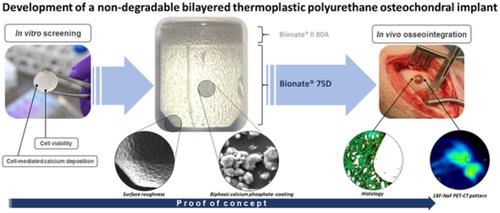当前位置:
X-MOL 学术
›
J. Biomed. Mater. Res. Part B Appl. Biomater.
›
论文详情
Our official English website, www.x-mol.net, welcomes your
feedback! (Note: you will need to create a separate account there.)
In vitro and in vivo study on the osseointegration of BCP-coated versus uncoated nondegradable thermoplastic polyurethane focal knee resurfacing implants.
Journal of Biomedical Materials Research Part B: Applied Biomaterials ( IF 3.2 ) Pub Date : 2020-07-02 , DOI: 10.1002/jbm.b.34672 Ralph M Jeuken 1 , Alex K Roth 1 , Marloes J M Peters 1 , Tim J M Welting 1 , Lodewijk W van Rhijn 1 , Jac Koenen 2 , Ruud J R W Peters 2 , Jens C Thies 2 , Pieter J Emans 1
Journal of Biomedical Materials Research Part B: Applied Biomaterials ( IF 3.2 ) Pub Date : 2020-07-02 , DOI: 10.1002/jbm.b.34672 Ralph M Jeuken 1 , Alex K Roth 1 , Marloes J M Peters 1 , Tim J M Welting 1 , Lodewijk W van Rhijn 1 , Jac Koenen 2 , Ruud J R W Peters 2 , Jens C Thies 2 , Pieter J Emans 1
Affiliation

|
Focal knee resurfacing implants (FKRIs) are intended to treat cartilage defects in middle‐aged patients. Most FKRIs are metal‐based, which hampers follow‐up of the joint using magnetic resonance imaging and potentially leads to damage of the opposing cartilage. The purpose of this study was to develop a nondegradable thermoplastic polyurethane (TPU) FKRI and investigate its osseointegration. Different surface roughness modifications and biphasic calcium phosphate (BCP) coating densities were first tested in vitro on TPU discs. The in vivo osseointegration of BCP‐coated TPU implants was subsequently compared to uncoated TPU implants and the titanium bottom layer of metal control implants in a caprine model. Implants were implanted bilaterally in stifle joints and animals were followed for 12 weeks, after which the bone‐to‐implant contact area (BIC) was assessed. Additionally, 18F‐sodium‐fluoride (18F‐NaF) positron emission tomography PET/CT‐scans were obtained at 3 and 12 weeks to visualize the bone metabolism over time. The BIC was significantly higher for the BCP‐coated TPU implants compared to the uncoated TPU implants (p = .03), and did not significantly differ from titanium (p = .68). Similar 18F‐NaF tracer uptake patterns were observed between 3 and 12 weeks for the BCP‐coated TPU and titanium implants, but not for the uncoated implants. TPU FKRIs with surface modifications could provide the answer to the drawbacks of metal FKRIs.
中文翻译:

BCP 涂层与未涂层的不可降解热塑性聚氨酯局灶性膝关节表面置换植入物的骨整合的体外和体内研究。
局部膝关节表面置换植入物 (FKRI) 旨在治疗中年患者的软骨缺损。大多数 FKRI 是金属基的,这会妨碍使用磁共振成像对关节进行随访,并可能导致对侧软骨的损伤。本研究的目的是开发不可降解的热塑性聚氨酯 (TPU) FKRI 并研究其骨整合。不同的表面粗糙度修改和双相磷酸钙 (BCP) 涂层密度首先在 TPU 盘上进行了体外测试。随后在山羊模型中将 BCP 涂层 TPU 植入物的体内骨整合与未涂层 TPU 植入物和金属对照植入物的钛底层进行比较。双侧膝关节植入物,对动物进行随访 12 周,之后评估骨与种植体接触面积(BIC)。此外,在第 3 周和第 12 周获得 18F-氟化钠 (18F-NaF) 正电子发射断层扫描 PET/CT 扫描,以可视化随时间推移的骨代谢。与未涂层 TPU 植入物相比,BCP 涂层 TPU 植入物的 BIC 显着更高(p = .03),并且与钛没有显着差异(p = .68)。对于 BCP 涂层 TPU 和钛植入物,在 3 至 12 周之间观察到类似的 18F-NaF 示踪剂摄取模式,但未涂层植入物则不然。具有表面改性的 TPU FKRI 可以解决金属 FKRI 的缺点。
更新日期:2020-07-02
中文翻译:

BCP 涂层与未涂层的不可降解热塑性聚氨酯局灶性膝关节表面置换植入物的骨整合的体外和体内研究。
局部膝关节表面置换植入物 (FKRI) 旨在治疗中年患者的软骨缺损。大多数 FKRI 是金属基的,这会妨碍使用磁共振成像对关节进行随访,并可能导致对侧软骨的损伤。本研究的目的是开发不可降解的热塑性聚氨酯 (TPU) FKRI 并研究其骨整合。不同的表面粗糙度修改和双相磷酸钙 (BCP) 涂层密度首先在 TPU 盘上进行了体外测试。随后在山羊模型中将 BCP 涂层 TPU 植入物的体内骨整合与未涂层 TPU 植入物和金属对照植入物的钛底层进行比较。双侧膝关节植入物,对动物进行随访 12 周,之后评估骨与种植体接触面积(BIC)。此外,在第 3 周和第 12 周获得 18F-氟化钠 (18F-NaF) 正电子发射断层扫描 PET/CT 扫描,以可视化随时间推移的骨代谢。与未涂层 TPU 植入物相比,BCP 涂层 TPU 植入物的 BIC 显着更高(p = .03),并且与钛没有显着差异(p = .68)。对于 BCP 涂层 TPU 和钛植入物,在 3 至 12 周之间观察到类似的 18F-NaF 示踪剂摄取模式,但未涂层植入物则不然。具有表面改性的 TPU FKRI 可以解决金属 FKRI 的缺点。











































 京公网安备 11010802027423号
京公网安备 11010802027423号